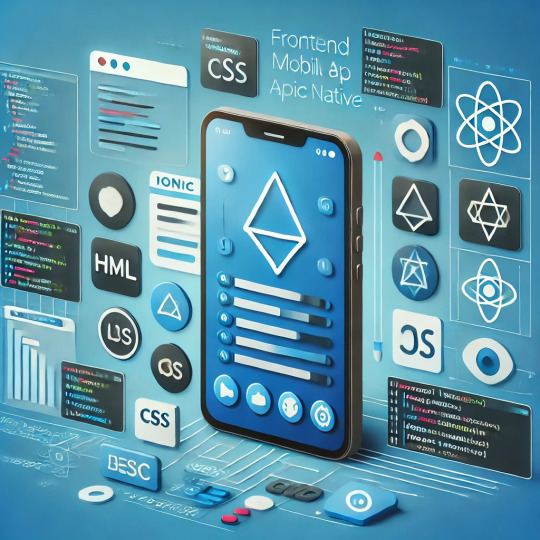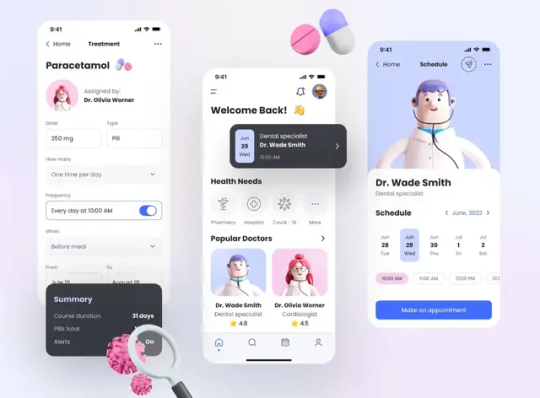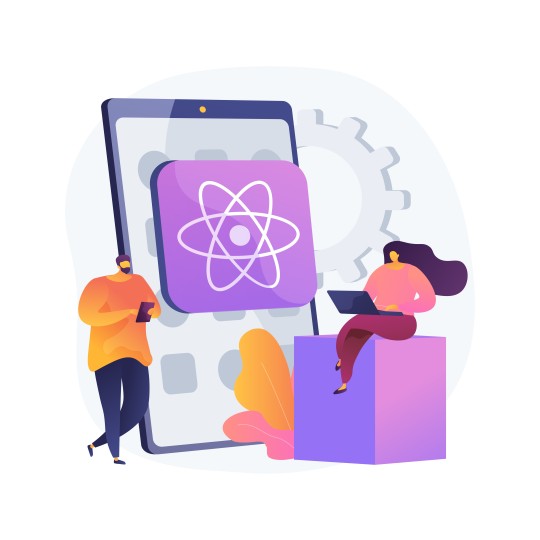#JavaScript for mobile apps
Explore tagged Tumblr posts
Text
Frontend Development for Mobile Apps with Frameworks like Ionic or React Native

In today's fast-paced digital world, businesses are increasingly seeking efficient ways to build high-quality mobile apps. Frontend development plays a crucial role in creating responsive and user-friendly mobile applications. Two popular frameworks for mobile app frontend development are Ionic and React Native. Both frameworks allow developers to build cross-platform apps, reducing development time and cost. In this article, we’ll explore how these frameworks work and the benefits they offer for mobile app development.
What is Frontend Development in Mobile Apps?
Frontend development focuses on the user interface (UI) and user experience (UX) of an application. For mobile apps, this involves creating interactive elements like buttons, menus, and layouts that users interact with. With the increasing demand for mobile apps, businesses need to deliver seamless user experiences across different platforms, including iOS and Android. This is where frameworks like Ionic and React Native come in.
Why Choose Cross-Platform Frameworks for Mobile App Development?
Building separate apps for iOS and Android can be time-consuming and expensive. Cross-platform frameworks like Ionic and React Native allow developers to write a single codebase that works on both platforms. This not only speeds up the development process but also reduces maintenance efforts. Here are the benefits of using these frameworks:
Cost Efficiency: With a single codebase, companies save money on development and updates.
Faster Development: Developers can launch apps quicker by writing code once and deploying it across platforms.
Consistent UI/UX: Ensures a unified look and feel on both iOS and Android devices.
Ionic Framework for Mobile App Development
Ionic is an open-source framework that uses web technologies like HTML, CSS, and JavaScript to build mobile apps. It's built on top of Angular and integrates well with Apache Cordova, enabling access to native device features like the camera and GPS.
Key Features of Ionic:
Cross-Platform Compatibility: Build apps that run smoothly on both iOS and Android.
Pre-Built UI Components: Ionic offers a wide range of ready-made components, speeding up the design process.
Native Plugin Integration: Access native device functionalities through plugins, without writing native code.
Web View: Apps are rendered in a web view, making it easier for web developers to transition to mobile app development.
Advantages of Ionic:
Perfect for developers familiar with web technologies.
Large community support with extensive documentation.
Fast prototyping for MVP (Minimum Viable Product) development.
React Native for Mobile App Development
React Native, developed by Facebook, is another powerful framework for building cross-platform mobile apps. Unlike Ionic, which uses web technologies, React Native allows developers to write native code for both platforms using JavaScript. This provides better performance compared to web-view-based frameworks.
Key Features of React Native:
Native Components: React Native renders real native components, ensuring faster performance.
Hot Reloading: Developers can instantly see changes without recompiling the entire app.
JavaScript and React: Leverages JavaScript and the popular React library, making it easier for web developers to adopt.
Third-Party Plugins: React Native has a rich ecosystem of third-party plugins for extended functionality.
Advantages of React Native:
Near-native performance for both iOS and Android apps.
Reusable components across platforms.
Large developer community and regular updates from Facebook.
Ionic vs React Native: Which One to Choose?
Choosing between Ionic and React Native depends on the specific needs of your project. Here are some points to consider:
Performance: If performance is critical and you need a near-native feel, React Native is the better option.
Development Speed: For rapid prototyping and building MVPs, Ionic is faster due to its pre-built UI components and web-based architecture.
Familiarity with Technologies: If your team is experienced with Angular, Ionic is an easier choice. If they are more familiar with JavaScript and React, then React Native would be the better option.
The Future of Mobile Frontend Development
The demand for cross-platform mobile apps is growing, and frameworks like Ionic and React Native are at the forefront of this trend. As technology evolves, these frameworks continue to improve, offering better performance, more features, and easier integrations with backend systems. The future of frontend mobile development lies in the ability to create high-performance, cost-effective, and user-friendly apps that work seamlessly across all devices.
Conclusion
Both Ionic and React Native are powerful tools for frontend mobile app development. Choosing the right framework depends on your project’s goals, timeline, and the expertise of your development team. If you're looking to develop a mobile app that offers fast performance, cost efficiency, and a seamless user experience, either of these frameworks can be a great choice. Explore both options and see which fits your needs best for building high-quality mobile apps.
#Frontend mobile app development#Ionic framework for mobile apps#React Native for cross-platform apps#Cross-platform mobile app development#Mobile app frameworks#JavaScript for mobile apps#Ionic vs React Native#Mobile UI/UX development#ahextechnologies#reactnative#ionic
0 notes
Text
#digital aptech#reactjs#javaprogramming#javascript#coding#react.js#next.js#next js#reactjs development company#reactjs development services#reactjs developers#web development#app development#mobile app development#next.js development company
2 notes
·
View notes
Text
Simple explanation of var, let and const in Javascript
Check here

#website development#digital marketing#it consulting#software development#mobile app development#javascript#coding#learn to code#developer#reactjs#information technology
2 notes
·
View notes
Text
Learn practical tips and strategies to scale your ReactJS apps with ease—clean, efficient, and built to grow.
#react#mobile app development#reactjs#react js#reactjs developers#javascript#webdevelopment#learntocode
0 notes
Text

A mobile-friendly website enhances user experience, improves SEO rankings, and boosts conversions. To build a high-performing, mobile-optimized website, consider working with 2Digit Innovations for expert mobile app and web development services.
#ui ux company#web developing company#web developers#app development#software development#mobile app development#software#app developers#app developing company#software design#coding#webdev#software engineering#javascript#engineering
0 notes
Text

How to Balance Fixing Performance Issues and Adding New Features in Web Applications?
In today’s digital landscape, web applications are essential for business operations, marketing, and consumer involvement. As organizations expand and consumer expectations rise, development teams are frequently confronted with the difficult task of balancing two key priorities: addressing performance issues and introducing new features.
While boosting performance improves the user experience and increases efficiency, new features are required to remain competitive and meet market demands. Prioritizing one over the other, on the other hand, might have negative consequences—performance concerns can lead to a poor user experience while failing to innovate can result in a competitive disadvantage.
This blog delves into how to balance improving performance and introducing new features to web apps, allowing firms to satisfy technical and market demands efficiently.
Why Balancing Performance and New Features Is Crucial
A web application‘s success depends on both its performance and its features. However, relying entirely on one might result in imbalances that impair both user happiness and business progress.
Performance:Performance is an important component that directly influences user retention and happiness. Users can become frustrated and leave if the application has slow loading times, crashes, or problems. Ensuring that your web application runs smoothly is essential since 53% of mobile consumers would quit a site that takes more than three seconds to load.
New Features:On the other hand, constantly adding new features keeps users interested and promotes your company as innovative. New features generate growth by attracting new consumers and retaining existing ones who want to experience the most recent changes.
The dilemma is deciding when to prioritize bug fixes over new feature development. A poor balance can harm both performance and innovation, resulting in a subpar user experience and stagnation.
Common Performance Issues in Web Applications
Before balancing performance and features, it’s important to understand the common performance issues that web applications face:
Slow Load Times: Slow pages lead to higher bounce rates and lost revenue.
Server Downtime: Frequent server outages impact accessibility and trust.
Poor Mobile Optimization: A significant portion of web traffic comes from mobile devices and apps that aren’t optimized for mobile fail to reach their potential.
Security Vulnerabilities: Data breaches and security flaws harm credibility and user trust.
Bugs and Glitches: Software bugs lead to poor user experiences, especially if they cause the app to crash or become unresponsive.
Strategic Approaches to Fixing Performance Issues
When performance issues develop, they must be handled immediately to guarantee that the online application functions properly. Here are techniques for improving performance without delaying new feature development:
Prioritize Critical Issues:Tackle performance issues that have the most significant impact first, such as slow loading times or security vulnerabilities. Use analytics to identify bottlenecks and determine which areas require urgent attention.
Use a Continuous Improvement Process:Continuously monitor and optimize the application’s performance. With tools like Google PageSpeed Insights, you can track performance metrics and make incremental improvements without major overhauls.
Optimize Database Queries:Slow database queries are one of the leading causes of web app performance issues. Optimize queries and ensure that the database is indexed properly for faster access and retrieval of data.
Reduce HTTP Requests:The more requests a page makes to the server, the slower it loads. Minimize requests by reducing file sizes, combining CSS and JavaScript files, and utilizing caching.
5. Leverage Caching and CDNs: Use caching strategies and Content Delivery Networks (CDNs) to deliver content quickly to users by storing files in multiple locations globally.
Why Adding New Features is Essential for Growth
In the rapidly changing digital environment, businesses must continually innovate to stay relevant. Adding new features is key to maintaining a competitive edge and enhancing user engagement. Here’s why:
User Expectations:Today’s consumers expect personalized experiences and constant innovation. Failure to add new features can lead to customer churn, as users may feel your web application no longer meets their needs.
Market Differentiation:Introducing new features allows your application to stand out in the marketplace. Unique functionalities can set your app apart from competitors, attracting new users and increasing customer loyalty.
Increased Revenue Opportunities:New features can lead to additional revenue streams. For example, adding premium features or new integrations can boost the app’s value and lead to increased sales or subscription rates.
4. Feedback-Driven Innovation: New features are often driven by user feedback. By continuously developing and adding features, you create a feedback loop that improves the overall user experience and fosters customer satisfaction.
Read More: https://8techlabs.com/how-to-balance-fixing-performance-issues-and-adding-new-features-in-web-applications-to-meet-market-demands-and-enhance-user-experience/
#8 Tech Labs#custom software development#custom software development agency#custom software development company#software development company#mobile app development software#bespoke software development company#bespoke software development#nearshore development#software development services#software development#Website performance testing tools#Speed optimization for web apps#Mobile-first web app optimization#Code minification and lazy loading#Database indexing and query optimization#Agile vs Waterfall in feature development#Feature flagging in web development#CI/CD pipelines for web applications#API performance optimization#Serverless computing for better performance#Core Web Vitals optimization techniques#First Contentful Paint (FCP) improvement#Reducing Time to First Byte (TTFB)#Impact of site speed on conversion rates#How to reduce JavaScript execution time#Web application performance optimization#Fixing performance issues in web apps#Web app performance vs new features#Website speed optimization for better UX
0 notes
Text
Best Coding Languages to Learn in 2025 for Career Growth
Looking to boost your career in tech? Learning the best programming languages in 2025 can help you land high-paying jobs and stay competitive in the ever-evolving tech industry. From Python and JavaScript to emerging languages shaping AI, mobile app development company solutions, and web development, we cover the must-learn coding skills for career growth. Whether you’re an aspiring developer or a seasoned pro, this guide highlights the most in-demand programming languages for success in 2025.

#programming#coding#python#java#javascript#appdevelopment#mobileappdevelopment#softwaredevelopment#techtrends#digitalinnovation#mobile app development
0 notes
Text
Discover cost-effective strategies for SMBs to adopt AI in 2025. Learn about budgeting, solutions, and tools to streamline operations and maximize ROI.
#AI agent process automation for manufacturing#custom enterprise blockchain development#custom javascript development services#flutter mobile app development#flutter for mobile app development
0 notes
Text
plixgo
https://plixgo.com/items/2d-animation-reels-bundle/1016

#WordPress Templates#Plugins#PHP Scripts#and Graphics Digital Marketplace#JavaScript#CSS#HTML5#Site Templates#WordPress Themes#Mobile Apps#Graphics#Prints#Brochures#Flyers#Resumes#and More...
1 note
·
View note
Text
#website development#ai solutions#custom software development#mobile application development#ui ux design#reactjs#javascript#figma#html css#generative ai#gen ai#ai writing#llm#ai technology#artificial intelligence#seo services#web development#flutter app development#hiring#ruby on rails development company#internship#freshers#career#job
0 notes
Text
Why Tech Mind Developers Uses React Technology for Web Development

At Tech Mind Developers, we always strive to offer the most efficient, scalable, and user-friendly digital solutions. One of the technologies we frequently leverage for web development is React. React, developed by Facebook, has become one of the most popular JavaScript libraries for building dynamic, fast, and responsive web applications.
In this article, we’ll explore why React is such a powerful tool and how it can benefit your business.
Why We Use React at Tech Mind Developers
1. Faster Development Process React allows us to build applications faster and more efficiently. It offers reusable components, which means developers can reuse code for different parts of the application, speeding up the development process. This helps us deliver your project quicker, saving both time and costs.
2. High Performance React is designed to enhance the user experience by minimizing page loading times. Its Virtual DOM optimizes the rendering process, ensuring that only the components that need updating get refreshed. This boosts the performance of your website or application, providing users with a seamless experience.
3. Scalability and Flexibility React is highly scalable, making it easy to add new features or extend existing ones as your business grows. Whether you’re starting with a simple web app or planning a more complex platform, React gives us the flexibility to scale your project according to your needs.
4. SEO-Friendly One of the challenges with traditional JavaScript frameworks is their SEO performance. React overcomes this by supporting server-side rendering (SSR), making it easier for search engines to index your content. At Tech Mind Developers, we ensure that your website is not only user-friendly but also optimized for search engines to improve visibility.
5. Strong Community Support React boasts a large community of developers worldwide, which means continuous updates, improvements, and a vast range of resources. This ensures that we stay updated on the latest best practices, helping us build cutting-edge solutions for your business.
Benefits of Using React for Your Business
1. Improved User Experience React enables the creation of highly interactive and responsive interfaces, which ensures that your website visitors have a smooth and enjoyable experience. A better user experience means more engagement, leading to higher conversion rates.
2. Cost-Effective Development Because React allows us to reuse components, the development process is more efficient, reducing the time and resources needed to build your application. This translates into cost savings for your business.
3. Faster Time to Market The efficiency of React’s reusable components and its flexibility means we can get your product to market faster. Whether it’s an e-commerce platform, business dashboard, or custom web application, React enables us to build high-quality solutions within shorter timelines.
4. Easy Maintenance React’s modular structure makes it easier to maintain your application in the long run. If you need updates or new features, it’s simple for us to implement changes without affecting the overall stability of the system.
5. Future-Proof Technology React is constantly evolving with new updates and features, ensuring your application will remain up-to-date with modern web standards. By choosing React, you are investing in a future-proof technology that will serve your business well in the years to come.
Why Choose Tech Mind Developers for React Development?
At Tech Mind Developers, we have a team of skilled developers who are well-versed in React and its ecosystem. We leverage the best practices in React development to build scalable, fast, and intuitive applications tailored to your business needs. Whether you’re looking to build a new web application from scratch or revamp an existing one, we are here to help.
Contact Us:
For more information on how we can help with your React development needs, feel free to reach out to us.
📞 +91–7835019421 ✉️ [email protected]
#reactjs #webdevelopment #reactdevelopment #reactapps #techminddevelopers #seo #javascript #userexperience #digitaltransformation #customwebapps #websitedesign #scalablewebsites
#techminddevelopers#softwaredevelopment#mobile app development#softwaredesign#websitedevelopment#best software company in patna#delhincr#mobileapplications#softwaresolutions#aligarh#reactjs#webdevelopment#reactdevelopment#reactapps#seo#javascript#customwebapps#websitedesign
0 notes
Text
Why Ionic Outperforms Flutter in 2024: 7 Data-Driven Reasons to Choose Ionic

In the competitive realm of hybrid app development, selecting the right framework is crucial for ensuring the success of your project. As of 2024, Flutter and Ionic are the two leading contenders in the field. While both frameworks have their strengths, an in-depth analysis of data and technical aspects reveals that Ionic may have the edge for many developers and businesses. Here’s why Ionic stands out, supported by compelling statistics and technical insights.
1. Hybrid Approach Enhances Performance
Performance is a pivotal factor in choosing a development framework. Ionic’s hybrid approach utilizes pre-existing plugins and technologies that enhance development efficiency while maintaining high performance. Ionic delivers a consistent 60 FPS across both desktop and mobile platforms, demonstrating its ability to offer smooth and reliable user experiences.
Flutter, known for its native compilation and custom rendering engine, also achieves 60 FPS. However, while Flutter’s hot reload feature can accelerate development, it doesn’t always translate to faster overall development time. Data suggests that Flutter's hot reload can reduce development time by up to 63%, but this benefit is often counterbalanced by the complexity of the app being developed.
2. Superior UI Customization and Flexibility
UI design flexibility is another critical factor where Ionic excels. Ionic leverages web technologies such as HTML, CSS, and JavaScript, providing developers with a comprehensive library of pre-designed components. This allows for highly customizable and responsive UIs, with standard-based web components that can be styled to resemble native elements, ensuring a consistent look and feel across various platforms.
Flutter, in contrast, employs its own rendering engine and offers a range of pre-designed widgets. While these widgets adhere to Material Design and Human Interface guidelines and provide extensive customization options, they may not offer the same level of flexibility as the standard web components used by Ionic. For businesses seeking a tailored UI with rapid implementation, Ionic’s approach offers a significant advantage.
3. Enhanced Code Portability and Maintenance
Code portability is a crucial aspect of modern app development, and Ionic’s use of web technologies facilitates this with ease. Developers can deploy a single codebase across mobile, desktop, and Progressive Web Apps (PWA), simplifying code maintenance and updates. This approach reduces the time and effort required to manage different platform versions.
Flutter also supports cross-platform code sharing but relies on Dart, which is less widely adopted than JavaScript. Although Flutter's single codebase approach is effective, developers may face a steeper learning curve with Dart, potentially impacting the speed of development and onboarding.
4. Developer-Friendly Ecosystem
The developer experience is greatly influenced by the ecosystem surrounding a framework. Ionic’s ecosystem is designed to enhance developer convenience, offering extensive documentation and compatibility with popular JavaScript frameworks such as AngularJs , React, and Vue. This integration allows developers to leverage their existing skills and tools, facilitating faster development and maintenance.
Flutter requires proficiency in Dart, a less common language compared to JavaScript. Although Flutter provides comprehensive documentation, the learning curve associated with Dart can be a barrier for new developers or those transitioning from other languages. Ionic’s ecosystem, with its focus on familiar technologies, presents a more accessible option for many developers.
5. Accelerated Development and Deployment
Speed is critical in the app development lifecycle. Ionic’s hybrid approach and efficient use of web technologies contribute to quicker development cycles. With its vast library of components and plugins, developers can rapidly assemble and deploy applications, minimizing the need for extensive custom coding.
Flutter’s hot reload feature is designed to speed up development by allowing real-time updates without restarting the app. While this feature is beneficial, the overall speed of development can still be affected by the complexity of the application and the need for frequent updates. Ionic’s streamlined approach often results in faster development and deployment times.
6. Cost-Effective Development
Cost considerations are always at the forefront of app development decisions. Ionic’s utilization of web technologies and pre-existing plugins often results in more cost-effective development compared to Flutter. The use of JavaScript and established web frameworks typically leads to lower development costs, as teams can build on their existing knowledge and tools.
In contrast, Flutter’s development costs may be higher due to the need for specialized Dart expertise and potentially longer development times for complex applications. Although Flutter can deliver high-performance apps, the associated costs can be a significant factor for businesses operating within tight budgets.
7. Established Community and Support
Community support and available resources play a crucial role in the development process. Ionic’s longer presence in the market has fostered a robust ecosystem of resources, tutorials, and community support. This established network provides valuable assistance for troubleshooting, learning, and keeping up with the latest advancements.
While Flutter is supported by a rapidly growing community and benefits from Google’s backing, it is relatively newer compared to Ionic. As a result, the community support and resources for Flutter are still expanding. For developers seeking a well-established support network, Ionic’s longstanding presence offers a substantial advantage.
Ionic’s Technical Superiority
Ionic excels not only in performance and development efficiency but also through its robust technical features:
Plugin Integration: Ionic utilizes Cordova and, more recently, Capacitor plugins to access host operating system features such as Camera, GPS, and Flashlight. This integration allows developers to build applications that leverage native device functionalities while using a unified codebase.
Comprehensive Framework: Ionic supports building apps that can be customized for a range of platforms, including Android, iOS, Windows, Desktop (with Electron), and modern browsers. This versatility is facilitated through Ionic’s build tools and simplified command-line interface (CLI), which streamlines the app-building and deployment process.
Extensive UI Components: Ionic includes a wide array of mobile components, typography, interactive paradigms, and an extensible base theme. Web Components used in Ionic provide custom elements and methods for interaction. Notable components like virtual scroll allow for smooth scrolling through extensive lists, while tabs create native-style navigation with history state management.
Development Tools: Ionic offers services that enable code deploys and automated builds. Although its own IDE, Ionic Studio, was discontinued in 2020, the CLI remains a powerful tool for project creation, plugin management, push notifications, and native binary generation.
Conclusion
In conclusion, while both Flutter and Ionic offer distinct benefits for hybrid app development, data and technical insights indicate that Ionic may be the preferable choice for many projects. With its hybrid approach, superior UI customization, code portability, and developer-friendly ecosystem, Ionic presents a compelling option for businesses looking to develop high-performance, cost-effective applications.
If you're considering developing a new application or updating an existing one, hiring Ionic developers could significantly enhance your project’s success. Ionic’s strengths in development efficiency and technical versatility make it a robust and effective choice in the competitive landscape of hybrid app development.
By choosing Ionic, and with the expertise of skilled Ionic developers, you can harness a framework with a proven track record, ensuring efficient development and deployment processes. For a well-established support network and a streamlined development experience, Ionic is the framework to consider.
#Flutter#Ionic#Mobile App Development#Cross Platform Apps#App Development#Hybrid Apps#IonicFramework#Flutter VS IONIC#Tech Comparison#App Performance#Dart Programming#JavaScript Frameworks#Mobile Development Trends#Capacitor#Cordova Plugins
0 notes
Text
Developing JavaScript Applications That Are Scalable: Tools and Best Practices
Developing scalable apps with JavaScript app development requires best practices like modular code architecture, effective use of frameworks (e.g., Node.js, React), and implementing asynchronous programming. Key tools include microservices, load balancers, and cloud-based solutions for managing traffic spikes. JavaScript app development should also focus on performance optimization, utilizing caching techniques, and employing automated testing to ensure that apps remain dependable and responsive as user demand increases.
0 notes
Text
React Native vs Ionic—which mobile app framework is right for you? Dive into the pros, cons, and key differences to make the best choice.
0 notes
Text
Is React Native the Right Choice for Your Mobile App Development?
In today’s world, most people use smartphones, and businesses need high-quality apps to reach them. There are two main phone systems, Apple’s iOS and Google’s Android. Businesses can’t decide which one to make an app for first. This is where React Native comes in – it can help solve this problem.
What is React Native?
React Native is a framework tool for building mobile apps that uses JavaScript, a common programming language. Imagine you want to build a mobile app that works on both iPhones and Android phones. Traditionally, you would need to write separate code for each platform, which can be time-consuming and expensive.
React Native is a tool that simplifies this process. It lets you use JavaScript, a common programming language that many developers already know, to write most of the app’s code. Then, React Native translates that code into code that iPhones and Android phones can understand.
This means you can write most of the app once and use it on both platforms, saving you time and money. It’s like using a universal translator for your app code!
Why Choose React Native?
Here are some compelling benefits of React Native for your next mobile app:
Cost-Effective: Normally, building separate apps for iPhone and Android requires different codes for each. It lets you write most of the code once and use it for both versions, saving you time and money on development.
Faster Time to Market: With one codebase, development goes quicker. This means you can launch your app on both iOS and Android app stores sooner, reaching more people faster. You can also gather feedback from real users quickly and improve your app based on their experience.
Native-like UI: Build smooth and polished user interfaces that look and feel like natural iOS or Android apps.
Large Developer Community: Leverage the vast pool of JavaScript developers for building and troubleshooting your app.
Live Reloading: Imagine tinkering with your app’s code and seeing those changes reflected on the spot! This is what React Native’s live reloading feature allows you to do. It makes development efficient as you can experiment and see the results immediately without restarting the app every time.
Access to Native Features: Integrate native functionalities like camera or GPS into your app seamlessly.
Is React Native Right for Your App?
While there are number of benefits it provides but it’s not a perfect fit for every app. These are a few limitations of using react native. Here are some things to consider.
App Complexity: If your app is super complicated and has very unique features, building it directly for each device (native development) might be better. React Native is great for simpler apps or those with moderate complexity.
Performance Requirements: If your app uses fancy graphics or needs to interact with the device in very precise ways, native development might be faster.
Who Uses React Native?
You might hear some people dismiss React Native as a passing fad. But that’s simply not the case. Major companies like Facebook, Instagram, Skype, and Uber rely on it to build their mobile apps. This widespread adoption by big players is a strong sign that the framework is a trustworthy and effective tool for creating mobile applications.
Conclusion
React Native is a framework for building native mobile apps using JavaScript and React’s component-based UI. React Native offers a compelling solution for businesses looking to build high-quality mobile apps efficiently and cost-effectively. With its growing popularity and vast developer community, it is poised to play a significant role in the future of mobile app development. So, if you’re considering building a mobile app, give it a serious look!
1 note
·
View note